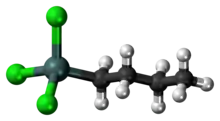 | |
 | |
| Names | |
|---|---|
| Preferred IUPAC name
Butyltri(chloro)stannane | |
| Identifiers | |
3D model (JSmol) |
|
| 4-04-00-04346 | |
| ChemSpider | |
| ECHA InfoCard | 100.012.967 |
| EC Number |
|
PubChem CID |
|
| RTECS number |
|
| UNII | |
| UN number | UN3265 [1] |
CompTox Dashboard (EPA) |
|
| |
| Properties | |
| C4H9SnCl3 | |
| Molar mass | 282.18 |
| Appearance | Clear liquid [3] |
| Density | 1.693 g/cm3 |
| Melting point | −63 °C (−81 °F; 210 K) |
| Boiling point | 93 °C (199 °F; 366 K) at 10 mmHg (lit.) |
| Solubility | Soluble in most common organic solvents |
| Vapor pressure | 0.077 mm Hg at 25°C [4] |
| Hazards | |
| Occupational safety and health (OHS/OSH): | |
Main hazards |
Combustible liquid, Harmful by ingestion, Harmful by skin absorption, Corrosive[5] |
| NFPA 704 (fire diamond) | |
| Flash point | 81 °C (178 °F; 354 K) |
| Lethal dose or concentration (LD, LC): | |
LD50 (median dose) |
2140 mg/kg (Oral rat) |
| Safety data sheet (SDS) | |
Except where otherwise noted, data are given for materials in their standard state (at 25 °C [77 °F], 100 kPa).
Infobox references | |
Monobutyltin trichloride, also known as MBTC, is an organotin compound. It is a colorless oil that is soluble in organic solvents.[6] Relative to other organotin compounds, MBTC is obscure and not widely used.
Applications
Glass coating
Monobutyltin trichloride has been examined as a precursor to tin dioxide coatings on glass. Such coatings, especially when doped, are low-emissivity and transparent to visible light, reflect infrared light, and provide a high conductance and a low sheet resistance.[7]
For example, MBTC is used in the manufacturing process of glass containers such as those used for beers, spirits, and juices. These glass-making processes heat raw materials (sand, soda-ash, limestone, and recycled glass) to produce molten glass. The molten glob is cut into smaller pieces of uniform size, and are then pressed in a mold. MBTC is applied on the external surface of these containers, and then, the glass is annealed and coated with polyethylene.[8]
MBTC is a commonly used organotin compound for on-line chemical vapor deposition because it readily decomposes at or close to the hot glass surface. The tin dioxide coatings formed are transparent to visible light, reflect infrared light, and are highly conductive. If these coatings are doped with fluorine from a source like trifluoroacetic acid (TFA), the coating will also have a lowered emissivity.[9]
PVC stabilizer
Monobutyltin trichloride is used as a polyvinyl chloride (PVC) stabilizer. PVC is used in mass production for various objects. One such object is a PVC based container for various wines and brandies (especially those produced in Canada). Consequently, the MBTC leaches into the wine along with other organotin compounds (some of which are used as wood preservatives for the wine barrels). These compounds are toxic to the human body, and the amount of organotin compounds, especially MBTC, have been the subject of a lot of food-safety based research.[10]
Another object PVC is used in is pipe production. Since these pipes are used to carry drinking water, the MBTC is leaching into the drinking water supply.[11]
Safety
Monobutyltin trichloride releases corrosive hydrogen chloride upon hydrolysis. Unlike some organotin compounds, it has relatively low toxicity.
See also
References
- ↑ "n-Butyltin trichloride, 96%". Alfa Aesar. Archived from the original on 24 December 2013. Retrieved 16 November 2012.
- ↑ "ChemSpider CSID:13600". ChemSpider. Retrieved 16 November 2012.
- ↑ "Monobutyltin Trichloride". Chemical Land 21. Archived from the original on 24 December 2013. Retrieved 18 October 2012.
- ↑ "Material Safety Data Sheet Butyltin trichloride, 97%". Fisher Scientific. Retrieved 19 October 2012.
- ↑ "Butyltin Trichloride Material Safety Data Sheet". Sigma-Aldrich. Retrieved 19 October 2012.
- ↑ Tagliavini, Giuseppe (2001). "n-Butyltrichlorostannane". e-EROS Encyclopedia of Reagents for Organic Synthesis.
- ↑ "Monobutyltin trichloride". Gulbrandsen. Retrieved 19 October 2012.
- ↑ Chad H. Dowell; Elena H. Page; Charles Mueller; Vince Mortimer (2005). "NIOSH Health Hazard Evaluation Report HETA #2003-0016-2959" (PDF). Lapel, Indiana: Centers for Disease Control and Prevention.
- ↑ Zhao, Hongli; Liu, Qiying; Cai, Yongxiu; Zhang, Fucheng (2008). "Effects of water on the structure and properties of F-doped SnO2 films". Materials Letters. 62 (8–9): 1294–1296. doi:10.1016/j.matlet.2007.08.042.
- ↑ Heroult, Julien; Bueno, Maite; Potin-Gautier, Martine; Lespes, Gaetane (2008). "Organotin speciation in French brandies and wines by solid-phase microextraction and gas chromatography—Pulsed flame photometric detection". Journal of Chromatography A. Laboratoire de Chimie Analytique Bio Inorganique et Environnement. 1180 (1–2): 122–130. doi:10.1016/j.chroma.2007.11.084. PMID 18177662.
- ↑ DeWitt, Jamie C.; Copeland, Carey B.; Luebke, Robert W. (2008). "An Organotin Mixture Found in Polyvinyl Chloride (PVC) Pipe is not Immunotoxic to Adult Sprague-Dawley Rats". Journal of Toxicology and Environmental Health, Part A. UNITED States. Environmental Protection Agency. 71 (4): 276–282. doi:10.1080/15287390701613025. PMID 18253893. S2CID 12387443.
